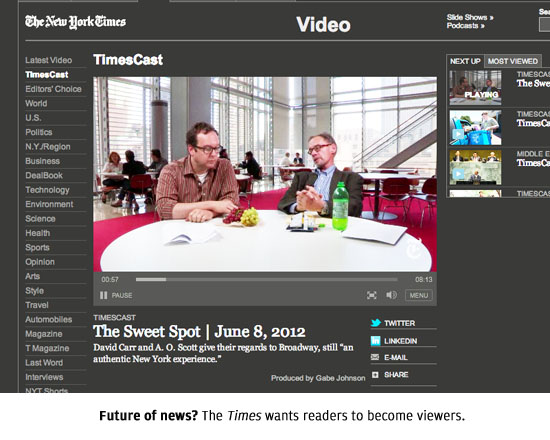
While the big three networks struggle to adapt to the world of mobile, on-demand delivery, a number of experiments are under way that seek to redefine the form and delivery of Web-based video journalism, and in the process to reinvent the newscast for the 21st century.
Some major print outlets are among the most committed of these video pioneers, as they try to turn their readers into viewers. In 2010, The New York Times launched TimesCast, its daily inside-the-newsroom webcast of top stories and short, edited conversations between Times staffers. In June, it added a morning business newscast called Business Day Live. The Times also has begun experimenting with Google+ Hangouts—interactive video chats—most prominently hosting a live “Hangout” on its homepage, on May 17, with UN Ambassador Susan Rice, moderated by columnist Nicholas Kristof.
Reuters, in partnership with YouTube, launched Reuters TV as a YouTube channel earlier this year. It generates several video segments each day—a mix of news, interviews, and commentary, with the occasional live report.
The Guardian has arguably been the most adventurous newspaper in its embrace of the video experiment. In addition to more typical fare—interview clips, news recaps, curated content—it produces original video reviews of music and films, how-to lifestyle segments, and full-immersion video travel guides for tablet users.
Not surprisingly, sports news is part of the mix, too. Three days a week at noon, The Boston Globe streams Boston Sports Live, while The Washington Post’s Post Sports Live “airs” weekly. (The Post also has announced plans to extensively expand its video-news offerings, especially of short, edited segments.)
The Wall Street Journal made a big push into video news over the past year, creating 1,500 videos a month, accessible on 18 different digital platforms. Its iPad-optimized WSJ Live show produces four hours of live video each weekday. In June, it launched Asia Today, an early-morning show focused on business and financial news in the region, and DC Bureau, a weekly politics show hosted by the Journal’s Washington bureau chief.
But inside-the-Beltway junkies needn’t wait on the Journal, as Politico, too, built a TV newsroom, complete with anchor desk, inside its Arlington, VA, offices earlier this year. On the evening of Super Tuesday,
Looking past, if not outright ignoring, the toe-dipping efforts of these print outlets are ventures from Huffington Post alums. With the working name of Planet Daily, a new—and still mysterious—video startup from HuffPo cofounder Ken Lerer and Eric Hippeau will launch later this summer, with both live and taped video-news segments. (Disclosure: Lerer is on CJR’s Board of Overseers.)
Also coming this summer is the much-anticipated launch of Huffington Post Live, headed by HuffPo founding editor Roy Sekoff. The live-streaming channel will have a staff of more than a hundred, and studios in New York and Los Angeles. It plans to webcast 12 hours of live video a day, expanding to 16 hours early next year. HPL is by far the most ambitious newcomer in the video-news game.
Finally, Sii.TV—a video-news project from Saul Hansell, a former New York Times tech reporter and, briefly, HuffPo editor—promises to curate the best video journalism on TV and the Web, and package it with original commentary.
Travel guides, live sportscasts, Google+ Hangouts—the near-future of the professionally produced newscast looks like a potato-sack race to an uncertain destination, in which the hoped-for prize is higher ad rates and greater audience engagement. The common hurdles for these efforts—whether on a tablet, a smartphone, or the Web—are how to produce video of sufficiently high quality at relatively low costs (compared with network TV), and how to habituate people to watching news in these novel ways. It’s a Cannonball Run to the future of video journalism. The winner gets the audience demographic that needs to Google that reference.
Sang Ngo
